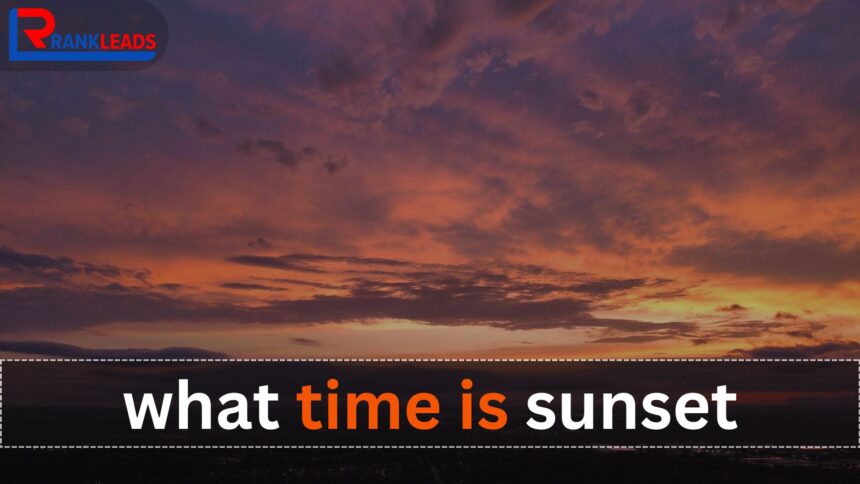Sunset is a magical time that marks the end of the day and the beginning of the night. It’s an event admired across cultures and celebrated for its beauty and significance. Understanding what time is sunset is essential for planning activities, capturing stunning photos, or simply pausing to reflect on the wonders of nature. This in-depth article will explore everything about sunsets, from the science behind them to their cultural and ecological importance.
The Science Behind Sunset
What Causes a Sunset?
A sunset occurs when the sun appears to sink below the horizon due to Earth’s rotation. This happens because the Earth spins on its axis, creating the illusion of the sun moving across the sky. As this celestial dance unfolds, the sun dips lower, resulting in the beautiful colors we associate with sunset.
During sunset, light passes through a thicker layer of the Earth’s atmosphere, scattering shorter wavelengths (blue and violet) and leaving behind longer wavelengths (red and orange). This scattering effect is why sunsets are often rich in warm hues.
Why Does Sunset Time Vary?
Latitude and Sunset Timing
Latitude significantly influences sunset times. Near the equator, sunset times remain relatively consistent throughout the year. In contrast, places closer to the poles experience dramatic variations in sunset times due to the tilt of the Earth’s axis.
For instance:
- At the equator, days and nights are nearly equal in length year-round.
- In the Arctic Circle during summer, the sun doesn’t set for weeks, a phenomenon known as the “Midnight Sun.”
Seasonal Changes
The tilt of the Earth’s axis causes seasons, which also affect the length of daylight. During summer, the sun sets later because the hemisphere experiencing summer tilts toward the sun. Conversely, in winter, shorter days result in earlier sunsets.
Tools to Determine Sunset Time
Knowing what time is sunset is easier than ever with modern tools.
Websites and Online Resources
Websites like TimeandDate and Weather.com provide accurate sunset timings for any location worldwide.
Mobile Apps
Apps like “Golden Hour” and “Sky Guide” help you track sunset times and even suggest the best times for photography. These apps often include features like moon phases, weather forecasts, and star maps, making them essential for nature enthusiasts.
How Time Zones Affect Sunset Timing
The Impact of Time Zones
Time zones, established to standardize time globally, directly influence local sunset times. For example, in the United States, sunset occurs earlier on the East Coast compared to the West Coast due to the difference in time zones.
Examples of Sunset Times Across Cities
- New York City: ~7:30 PM (Summer), ~4:30 PM (Winter)
- Los Angeles: ~8:00 PM (Summer), ~5:00 PM (Winter)
- London: ~9:20 PM (Summer), ~4:00 PM (Winter)
Bio Table: Sunset Timings and Key Factors
| Factor | Details |
|---|---|
| Latitude | Determines the variation in daylight hours throughout the year. |
| Season | Summer brings later sunsets, while winter causes earlier ones. |
| Weather | Cloud cover and pollution can affect the visibility and vibrancy of sunsets. |
| Time Zone | Local time zones influence the exact time the sun sets in a region. |
| Altitude | Higher altitudes experience sunsets slightly later due to a broader horizon. |
The Role of Weather in Sunset Visibility
Clouds and Atmospheric Conditions
Weather plays a significant role in the appearance of sunsets. Partly cloudy skies often create the most dramatic sunsets as light scatters off the clouds. Conversely, overcast conditions can obscure the sunset entirely.
Air Pollution and Sunset Colors
While pollution isn’t good for the environment, it can enhance sunset colors by scattering light into vivid reds and oranges. However, clean air provides clearer, more natural views of the setting sun.
Sunset and Its Cultural Significance
Art and Literature
Throughout history, sunsets have symbolized endings, transitions, and hope in art and literature. Famous works like Claude Monet’s sunset paintings capture the ephemeral beauty of this daily event.
Religious and Cultural Observances
In many religions, sunset holds spiritual significance. For example, Muslims pray the Maghrib prayer at sunset, and in Judaism, sunset marks the start of the Sabbath.
Best Places to Watch Sunsets
Famous Locations
- Santorini, Greece: Known for its breathtaking sunsets over the Aegean Sea.
- Grand Canyon, USA: Offers layered, colorful horizons as the sun sets over the cliffs.
- Uluru, Australia: The rock formation glows red at sunset, creating a magical atmosphere.
Hidden Gems
Even local parks, beaches, or mountain viewpoints can offer stunning sunset views if you know where to look.
The Importance of Knowing Local Sunset Times
Planning around what time is sunset can enhance activities like outdoor dining, beach outings, and evening hikes. Accurate sunset times also help photographers capture the “golden hour,” the period shortly before sunset when natural light is soft and flattering.
Tips for Sunset Enthusiasts
- Arrive Early: Get to your viewing spot at least 30 minutes before sunset.
- Check the Weather: Clear skies ensure better visibility.
- Bring Essentials: Carry a blanket, snacks, and a camera to enjoy the moment comfortably.
- Use Apps: Track sunset times and plan accordingly with reliable mobile apps.
FAQs
1. What is the best time to watch a sunset?
Arriving 20–30 minutes before sunset ensures you won’t miss the most vibrant colors as the sun dips below the horizon.
2. Does altitude affect sunset time?
Yes, higher altitudes experience sunsets slightly later as the horizon is visible farther away.
3. Why do sunsets look different every day?
Factors like weather, air pollution, and seasonal changes affect the colors and clarity of sunsets.
4. Are sunsets later near the equator?
Sunset times near the equator remain consistent throughout the year, unlike regions farther north or south.
5. Can sunsets predict the weather?
A red sunset often indicates clear weather the following day, while a gray or hazy sunset may signal rain.
6. What’s the difference between sunset and dusk?
Sunset marks when the sun dips below the horizon, while dusk is the period after sunset when the sky is still illuminated.
Conclusion
Sunsets are more than just a natural phenomenon—they’re a moment of reflection, a symbol of beauty, and an integral part of our daily lives. Knowing what time is sunset helps us appreciate this fleeting yet profound event, whether for spiritual practices, photography, or simple relaxa









